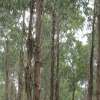
Study underway to improve durability to enhance the value of plantation, regrowth and regenerated eucalyptus
Posted 20 June 2020
Managing trees Economic benefits and markets Carbon benefits
Timber durability is generally rated by its resistance to fungal decay and insect attack and is a key factor for market acceptance of new building products.
Researchers at the University of Tasmania are investigating various aspects of the durability of plantation, regenerated and regrowth eucalyptus species.
Exciting research is underway at the University of Tasmania’s Centre for Sustainable Architecture with Wood (CSAW) that aims to shorten the timeframes for establishing the durability of plantation, regenerated and regrowth Eucalyptus timber products.
The research is largely funded by the National Institute for Forest Products Innovation as well as timber industry and research partners including the National Centre for Timber Durability and Design Life.
There is an excellent opportunity to enhance the value of plantation, regenerated and regrowth Eucalyptus timbers by using them to manufacture high quality and bespoke products for the built environment, instead of chipping them for much lower returns in the pulp and paper market.
However, many Eucalyptus species have low natural durability and need to be treated with chemical preservatives or otherwise modified before they can be safely used in the built environment.
In addition, plantation, regenerated and regrowth timbers are typically harvested at younger ages than the old growth timbers on which durability rating systems are based, and we have limited understanding of the durability characteristics of these much younger timbers.
Benchmarking natural and treated durability is a crucial first step for achieving broad market acceptance of new products made from plantation timbers.
Durability assessment generally takes a long time because the best way to assess durability is to put a piece of timber in or close to the ground and collect data, sometimes over several decades, as it decays.
These types of tests are generally known as ‘graveyard’ and ‘ground proximity’ tests and one has recently been installed at field trial site in Tasmania, with a sister site in tropical Queensland.
Whilst baseline natural durability data is being collected, research led by chief investigator Dr Kyra Wood, will continue into establishing shorter duration (commercially viable) durability assessment techniques suitable for use with collapse-prone hardwoods used in Australian conditions for external cladding, decking and composite products such as glulam.
Share this Article
Latest Articles
-

17 September 2025
Celebrating excellence at the Tasmanian Timber Awards
-

17 September 2025
Forest Practices Authority Research Update Day
-

13 August 2025
Have you seen our Stems for CO2 Project signage on the Midlands Highway?
Archives
- ActivAcre hits milestone, calls for more farmers to get on board
- Napier's leading the way in sustainable forestry and carbon-neutral farming
- Sound science needed to assess carbon impacts of timber harvesting
- Newly appointed TFFPN Board of Directors
- Graduate Certificate of Forestry Scholarship
- Forestry Australia Mentoring Program 2025
- Forest Industry Roundtable planning for the long term
- Eagle Management Constraint Period extended
- Successful private native forest management celebrated
- $15 million investment in new ship loader to boost Bell Bay's forestry exports
- Standing with Tasmania's forestry industry: buy local
- TFPA: Tasmanian Freight Equalisation Scheme needs a ground-up review
- AFCA Gala Dinner celebrates industry excellence
- Fire permits now required Statewide
- Forest leaders hone skills in sustainable native regrowth management
- Tasmanian forests and the carbon market: Barriers and opportunities
- Spring is the time for fuel reduction burning
- Primed for Growth: A situation analysis of the Tasmanian Forest and Wood Products Sector
- Audit requirements cut for low-risk plantation projects
- Guidance and support for landowners after damaging winds
- Forestry Australia welcomes further definition of active forest management
- Farm & Forest Mapper Tool highlighted at Rural Youth Tasmania's Young Farmer of the Year competition
- Senate Select Committee inquiry into the Tasmanian Freight Equalisation Scheme
- Timberlink announces new wood composite products brand
- Newly developed protocol a vital tool for safeguarding forestry industry
- Red Hot Tips: Fire management for Tassie farmers
- Bioenergy: Fuelling industries with trees
- Harvesting trees: What you need to know
- Shelterbelts: How are they contributing to farm systems?
- Infill plantings and remnant vegetation: Why biodiversity depends on a thriving understory
- Plantation planning: The key to a successful plantation
- Exciting interactive forestry knowledge hub launched
- $450,000 farm forestry grant recipients revealed



